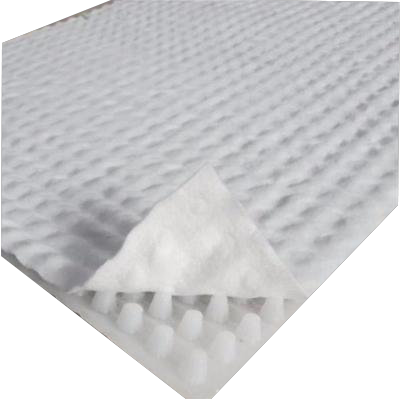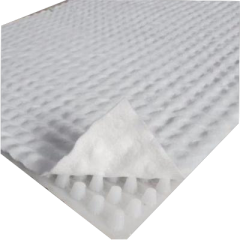YN-A502 convex shell waterproof and drainage board
Product Introduction
YN-A502 polymer waterproof and drainage board is made of polyethylene (HDPE) as raw material. The plastic base plate is pressed to form conical bosses or stiffening ribs (or hollow cylindrical porous) to form a drainage board. It adopts magic knot self-adhesive, which is convenient for construction at a high altitude. It has strong tensile properties, compressive strength and puncture resistance, as well as good hydrophobicity. It is widely used in railway, highway, subway and other tunnel waterproof and drainage projects.
Product Features
-
High tensile strength, above 13MPa at room temperature; large elongation at break, reaching over 700% at room temperature; good stress resistance and crack resistance, easy to adapt to water expansion and cracking of structures;
-
Good low-temperature bending performance, still maintaining good flexibility below -35°C; able to adapt well to changes in ambient temperature;
-
The product has excellent flexibility, wear resistance, and puncture resistance;
-
Resistant to corrosion by acids, alkalis, salts, and other media, as well as mold resistance. It has stable performance against acids, alkalis, and other chemicals in concrete or sandy soil, making it suitable for tunnels, civil engineering, and other projects;
-
Good constructability: the lap seam of the roll can be hot-melt welded to achieve the desired construction effect.
Scope of Application
- Mainly used for waterproofing of tunnels in railways and subways;
- Waterproofing of highway and railway culverts;
- Waterproofing, seepage prevention, and moisture-proofing works for various construction projects such as municipal engineering, sewage treatment tanks, and civil air defense projects;
- Seepage prevention works for water conservancy, dams, drainage ditches, artificial lakes, and other projects.
Construction Method
Tunnel Hanging and Laying Method without Anchors: The convex-concave plastic drainage board is bonded to the preset geotextile using Velcro;
(1) Surface Preparation Requirements: The base surface should be flat, clean, free of looseness, hollowing, and cracks, with a flatness satisfying D/L=1/10;
- D - The depth of the indentation between adjacent surfaces of the initial support base;
- L - The distance between adjacent convex surfaces of the initial support base;
(2) Metal components protruding from the base, such as reinforcing steel ends and anchor bolt heads, should be cut off and leveled with mortar. For metal components that cannot be cut off, such as anchor cable heads, they must be covered with sprayed concrete or mortar, with an arc radius R greater than 200mm;
(3) The internal and external corners and edges of the base surface need to be plastered with mortar to form an arc with a radius of 100mm;
(4) Only a small amount of occasional moisture stains are allowed on the base surface, and there must be no dripping, leaking, running water, streams, or mud flowing out. Before laying, carefully clean all debris from the base;
(5) When testing the double welds created by the double-weld automatic welding machine, clamp the ends of the welds tightly with iron clamps to prevent air leakage. Then, insert a test pin into the air groove between the two welds and pressurize it with a manual air pump to 0.25 Mpa. Observe for 15 minutes. If the pressure drop is less than 10%, it is considered qualified. If the pressure drop is too large and does not meet the requirements, promptly locate and repair the leak.
Precautions
- The plastic sheet is rolled into a cylindrical shape and packaged in plastic bags or woven bags.
- During transportation and storage, care should be taken to prevent damage to the packaging, and the material should be placed in a ventilated, dry location.
- The storage pile height should not exceed the height of five flat sheet rolls stacked. When stacking, place them on a dry, level surface, avoid direct sunlight, and prohibit contact with acids, alkalis, oils, organic solvents, etc. Keep them away from heat sources.
- During transportation, prevent tilting or squeezing, and cover with felt cloth if necessary.
- Under normal transportation and storage conditions, the storage period is 1 year.
Execution Standard: CR/Q562.3-2018《Railway Tunnel Waterproof and Drainage Materials, Part 3: Waterproof and Drainage Boards》


